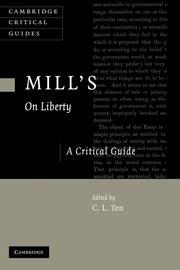Book contents
- Frontmatter
- Contents
- List of contributors
- Mill's On Liberty: Introduction
- 1 Mill's case for liberty
- 2 Mill's liberal principles and freedom of expression
- 3 Racism, blasphemy, and free speech
- 4 State neutrality and controversial values in On Liberty
- 5 Rawls's critique of On Liberty
- 6 Mill on consensual domination
- 7 Autonomy, tradition, and the enforcement of morality
- 8 Mill and multiculturalism
- 9 Mill, liberty, and (genetic) “experiments in living”
- 10 John Stuart Mill, Ronald Dworkin, and paternalism
- Bibliography
- Index
Mill's On Liberty: Introduction
Published online by Cambridge University Press: 01 July 2009
- Frontmatter
- Contents
- List of contributors
- Mill's On Liberty: Introduction
- 1 Mill's case for liberty
- 2 Mill's liberal principles and freedom of expression
- 3 Racism, blasphemy, and free speech
- 4 State neutrality and controversial values in On Liberty
- 5 Rawls's critique of On Liberty
- 6 Mill on consensual domination
- 7 Autonomy, tradition, and the enforcement of morality
- 8 Mill and multiculturalism
- 9 Mill, liberty, and (genetic) “experiments in living”
- 10 John Stuart Mill, Ronald Dworkin, and paternalism
- Bibliography
- Index
Summary
FREE EXPRESSION AND INDIVIDUALITY
In a letter to his wife, Harriet, of January 15, 1855, Mill discussed the urgency of writing an essay on liberty. He claims that “opinion tends to encroach more and more on liberty, and almost all projects of social reformers are really liberticide – Comte, particularly so.” On Liberty was published in 1859, the year after Harriet's death, and it carried a lavish dedication to her. Mill believed that the essay was “likely to survive longer than anything else that I have written (with the possible exception of the Logic).” On Liberty has not only survived, but it has also been the center of much discussion, most of it rather hostile. It has done so precisely because the tendency towards liberticide, to which Mill had alluded, remains a constant threat to individual liberty, as Mill conceived and cherished it.
But what is the nature of the liberty that Mill wanted to defend, and what are the sources of danger to it? First, Mill is very clear that the real danger to liberty comes from “a social tyranny,” which is greater than any kind of political oppression because “it leaves fewer means of escape, penetrating more deeply into the details of life, and enslaving the soul itself” (CW XVIII, 220 [1, 5]). He sees this tyranny as encroaching on both opinions and conduct, and thereby preventing the development of genuine individuality. The liberty he values therefore includes liberty of thought and discussion, and liberty of conduct.
- Type
- Chapter
- Information
- Mill's On LibertyA Critical Guide, pp. 1 - 21Publisher: Cambridge University PressPrint publication year: 2009



